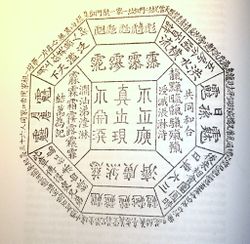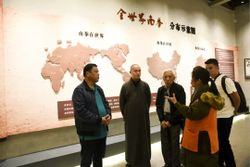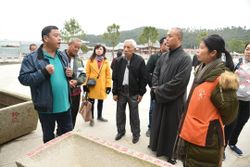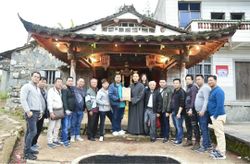تيانديهوي
| هذه المقالة هي جزء من سلسلة عن |
| تاريخ هونگ كونگ |
|---|
 |
| الخط الزمني |
| حسب الموضوع |
| Hongmen | |||||||||||||||||
|---|---|---|---|---|---|---|---|---|---|---|---|---|---|---|---|---|---|
| الصينية التقليدية | 洪門 | ||||||||||||||||
| الصينية المبسطة | 洪门 | ||||||||||||||||
| المعنى الحرفي | Hong Gate, Vast Gate, Floodgate | ||||||||||||||||
| |||||||||||||||||
| تيانديهوي | |||||||||||||||||
|---|---|---|---|---|---|---|---|---|---|---|---|---|---|---|---|---|---|
| الاسم الصيني | |||||||||||||||||
| الصينية التقليدية | 天地會 | ||||||||||||||||
| الصينية المبسطة | 天地会 | ||||||||||||||||
| المعنى الحرفي | Heaven and Earth Society | ||||||||||||||||
| |||||||||||||||||
| Vietnamese name | |||||||||||||||||
| Vietnamese | Thiên Địa Hội | ||||||||||||||||
| Sanhehui | |||||||||||||||||
|---|---|---|---|---|---|---|---|---|---|---|---|---|---|---|---|---|---|
| الصينية التقليدية | 三合會 | ||||||||||||||||
| الصينية المبسطة | 三合会 | ||||||||||||||||
| المعنى الحرفي | Three Harmonies Society | ||||||||||||||||
| |||||||||||||||||
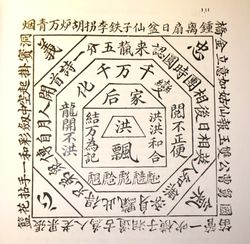
The Tiandihui (Chinese: 天地會; pinyin: Tiān Dì Huì)، وتعني حرفياً جمعية السماء والأرض، also called Hongmen 洪門 (the Vast Family), is a Chinese fraternal organisation and secretive folk religious sect such as the White Lotus Sect.[2] As the Tiandihui spread through different counties and provinces, it branched off into many groups and became known by many names, including the Sanhehui. The Hongmen grouping is today more or less synonymous with the whole Tiandihui concept, although the title "Hongmen" is also claimed by some criminal groups.
When the British ruled Hong Kong, all Chinese secret societies were seen as criminal threats and together defined as Triads, although the Hongmen might be said to have differed in its nature from others. The name of the "Three Harmonies Society" (the "Sanhehui" grouping of the Tiandihui) is in fact the source of the term "Triad" that has become synonymous with Chinese organised crime. Because of that heritage, the Tiandihui is sometimes controversial and is illegal in Hong Kong.
التاريخ
According to research based on primary sources made available to the public when the First Historical Archives in China opened in the 1980s, the first Tiandihui was started in 1762.[3]
The founders of the Tiandihui—Ti Xi, Li Amin, Zhu Dingyuan, and Tao Yuan—were all from Zhangpu, Zhangzhou, Fujian, on the border with Guangdong. They left Zhangpu for Sichuan, where they joined a cult, which did not go well. Ti Xi soon left for Guangdong, where he organised a group of followers in Huizhou. In 1761, he returned to Fujian and organised his followers to form the Tiandihui.
A century earlier, the Qing dynasty made membership in such societies illegal, driving them into the arms of the anti-Qing resistance, for whom they now served as an organizational model. The 18th century saw a proliferation of such societies, some of which were devoted to overthrowing the Qing, such as the Tiandihui, which had established itself in the Zhangpu and Pinghe counties of Zhangzhou by 1766. By 1767, Lu Mao had organised within the Tiandihui a campaign of robberies to fund their revolutionary activities.
The Tiandihui began to claim that their society was born of an alliance between Ming dynasty loyalists and five survivors of the destruction of Shaolin Monastery—Chua Teck Tiong (蔡德忠), Hong Dai Ang (方大洪), Ma Chew Heng (馬超興), Ho Teck Deh (胡德帝), and Lee Si Kai (李式開)—by the Qing forged at the Honghua Ting (Hung Fa Ting, Vast or Red Flower Pavilion), where they swore to devote themselves to the mission of "Fan Ching Fu Ming" (simplified Chinese: 反清复明; traditional Chinese: 反清復明; lit. 'Oppose Qing and restore Ming').[4]
The merchant Koh Lay Huan (died 1826),[5] who had been involved in these subversive activities, had to flee China, arriving in Siam and the Malay States, to eventually settle in Penang as its first Kapitan China.[6]
During the late 19th century, branches of the Hongmen were formed by Chinese communities overseas, notably the United States, Canada, and Australia.
بعد الإطاحة بأسرة تشينگ بالصين في 1911، وجد الهونگمن أنفسهم فجأة بلا هدف. ومـُذّاك فقد تفرق الهونگمن إلى جماعات مختلفة. While some other groups based within China, could no longer rely on donations from sympathetic locals; being unable to resume normal civilian lives after years of hiding, they turned to illegal activities – thus giving birth to the modern Triads.
الهونگمن اليوم
الهونگمن يُعتقد أنهم يتألفون من نحو 300,000 عضو في أرجاء العالم، ويتواجدون في الصين وتايوان والمجتمعات الصينية وراء البحار. Membership is overwhelmingly ethnically Chinese but there are also Japanese members and a few white American members. The Hongmen are divided into branches, of which there are believed to be approximately 180. The largest of the branches, Wu Sheng Shan, consists of perhaps 180,000 members. Membership is said to be primarily working class, and is also said to include a considerable membership in the armed forces of the Republic of China (Taiwan).
Hongmen members worldwide continue to observe certain common traditions: they all stress their patriotic origin; they all revere Guan Yu, a historic Chinese figure who embodies righteousness, patriotism, and loyalty; and they all share certain rituals and traditions such as the concept of brotherhood and a secret handshake.
هونگ كونگ
Today the Hongmen is an illegal society in Hong Kong, because of its links with the Triads, perceived or real.
تايوان
In Taiwan, by contrast, the Hongmen is not only legal, but politically influential; this came as no surprise, since Sun Yat-sen, founding father of the Republic of China, was a senior figure within the Hongmen, as was nationalist leader Chiang Kai-shek. Moreover, the Kuomintang, or Chinese Nationalist Party, was formed from the Xingzhonghui and Guangfuhui, groups not unlike the Hongmen.
Because of the Hongmen's revolutionary character and mysterious quality, their future was unclear after the Republic of China central government moved to Taiwan. For a long time, the Republic of China on Taiwan did not openly allow the Hongmen to operate. After martial law ended in 1989, Ge Shan Tang formed and started exchange with the outside world.
Under the influence of Chiang Kai-shek, the Hongmen attempted to remain secretive (although not exactly secret), but in recent years the organisation's activities have been more open.
The organisation also has business interests, and is reportedly trying to open a martial arts school in Taiwan.
On 1 January 2004, Nan Hua Shan Tang was registered with Taiwan's Ministry of Interior.
بر الصين الرئيسي
In Mainland China, the Hongmen is known as the Zhi Gong Party (致公党), a political party that participates in the Chinese People's Political Consultative Conference. Wan Gang, president of the Zhi Gong Party, is currently the only non-Communist Party minister in the Chinese government.
كندا
The Canadian branch was established in 1863 in Barkerville, British Columbia. In 1971, Chinese Freemasons National Headquarters of Canada (加拿大洪門民治黨) was incorporated under the Canadian Corporations Act on 31 May 1971, and registered on 22 July 1971.[7] The Barkerville headquarter was donated to British Columbia government.[8]
غيرهم
The Hongmen continues to exist within numerous overseas Chinese communities, albeit with rapidly ageing memberships; its main purposes today are to act as fraternities amongst overseas Chinese, and to participate in charitable activities. On 28 July 1992 the Hongmen held their 3rd Worldwide Hongmen Conference in the United States. Over 100 worldwide representatives attended for two days of discussion and adopted organizational rules, proclaimed the founding of a worldwide Hongmen association. First session President Li Zhipeng announced the construction of the Hongmen headquarters in هونولولو.
سـِيـَر
- A biography based on the Canadian Chinese Freemasons documents titled 'History of Hongmen and Chinese Freemasons in Canada' (洪門及加拿大洪門史論) was written by Dr. David Chuenyan Lai of University of Victoria.[10][11][12]
الثقافة الشعبية
الروايات
- The Deer and the Cauldron (鹿鼎記): a wuxia novel by Louis Cha. In the story, Tiandihui was prominently mentioned and played a major role in the story line. The protagonist, Wei Xiaobao, became the hall master of Tiandihui Qingmu Hall (青木堂) based in Peking (present day Beijing).
انظر أيضاً
المراجع
- ^ Alexander Wylie: Secret Societies in China, in China Researches, p131, 1897 Shanghai, reprinted in USA by Nabu Public Domain Reprints
- ^ Ownby (1995).
- ^ Murray, Dian (1994). The Origins of the Tiandihui: The Chinese Triads in Legend and History. Stanford, California: Stanford University Press. pp. 16–17. ISBN 9780804723244.
- ^ http://www.wingchunpedia.org/pmwiki/pmwiki.php?n=WCP.WingChunKuenAndTheSecretSocieties-CollectedInformationByReneRitchie
- ^ Rites of Belonging: Memory, Modernity, and Identity in a Malaysian Chinese Community By Jean DeBernardi, Jean Elizabeth DeBernardi Published by Stanford University Press, 2004; ISBN 0-8047-4486-6, ISBN 978-0-8047-4486-7; p. 26
- ^ The Straits Settlements, 1826–67: Indian Presidency to Crown Colony By Constance Mary Turnbull Published by Athlone Press, 1972; p. 9, 420
- ^ Chinese Freemasons
- ^ 百年历史的华人社团 加拿大洪门达权社
- ^ Putian South Shaolin Temple (2019-02-26). "34 people from Hongmen and Malaysia in Hongmen visited the Shaolin Temple in Putian" (in الصينية الكانتونية). Buddhist Online.
{{cite web}}: CS1 maint: unrecognized language (link) - ^ 「唐人街之父」新書 揭早期洪門秘史
- ^ 5月23日黎全恩博士讲座:【洪门及加拿大洪门史论】
- ^ Lecture by Dr. David Chuenyan Lai: History of Hongmen and Chinese Freemasons in Canada 黎全恩博士講座:【洪門及加拿大洪門史論】
المصادر
- Ownby, David (1995). "The Heaven and Earth Society as Popular Religion". The Journal of Asian Studies. 54 (4): 1023–1046. doi:10.2307/2059958. JSTOR 2059958.
{{cite journal}}: Invalid|ref=harv(help) - Jean Chesneaux; Lucien Bianco (1972). Popular Movements and Secret Societies in China, 1840–1950. Stanford University Press. ISBN 978-0-8047-0790-9.
